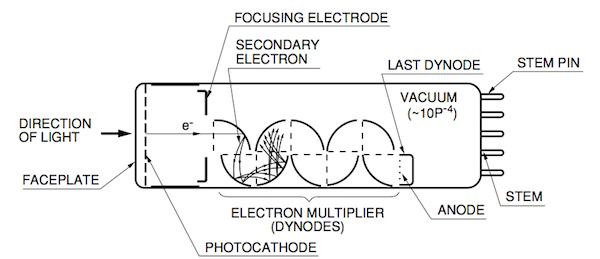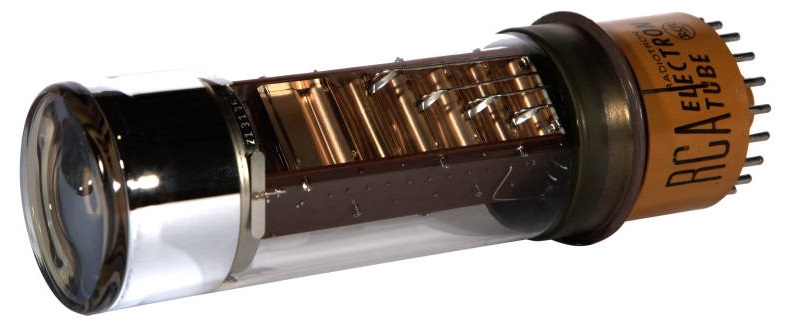Among the photosensitive devices in use today, the photomultiplier tube (or PMT) is a versatile device that provides extremely high sensitivity and ultra-fast response.
A typical photomultiplier tube consists of a photoemissive cathode (photocathode) followed by focusing electrodes, an electron multiplier and an electron collector (anode) in a vacuum tube.When light enters the photocathode, the photocathode emits photoelectrons into the vacuum. These photoelectrons are then directed by the focusing electrode voltages towards the electron multiplier where electrons are multiplied by the process of secondary emission.
The multiplied electrons are collected by the anode as an output signal. Because of secondary-emission multiplication, photomultiplier tubes provide extremely high sensitivity and exceptionally low noise among the photosensitive devices currently used to detect radiant energy in the ultraviolet, visible, and near infrared regions. The photomultiplier tube also features fast time response, low noise and a choice of large photosensitive areas.
HISTORY
In 1935, Iams succeeded in producing a triode photomultiplier tube with a photocathode combined with a single-stage dynode (Secondary emissive surface), which was used for movie sound pickup. In the next year 1936, Zworykin developed a photomultiplier tube having multiple dynode stages.
This tube enabled electrons to travel in the tube by using an electric field and a magnetic field.Then, in 1939, Zworykin and Rajchman developed an electrostatic-focusing type photomultiplier tube (this is the basic structure of photomultiplier tubes currently used). In this photomultiplier tube, an Ag-O-Cs photocathode was first used and later an Sb-Cs photocathode was employed.An improved photomultiplier tube structure was developed and announced by Morton in 1949) and in 1956.
Since then the dynode structure has been intensively studied, leading to the development of a variety of dynode structures including circular-cage, linear-focused and box-and-grid types. In addition, photomultiplier tubes using magnetic-focusing type multipliers transmission-mode secondary-emissive surfaces and channel type multipliers have been developed.
CONSTRUCTION
A photomultiplier tube is a vacuum tube consisting of an input window, a photocathode, focusing electrodes, an electron multiplier and an anode usually sealed into an evacuated glass tube. Figure shows the schematic construction of a photomultiplier tube.

Light which enters a photomultiplier tube is detected and produces an output signal through the following processes.
(1) Light passes through the input window.
(2) Light excites the electrons in the photocathode so that photoelectrons are emitted into the vacuum (external photoelectric effect).
(3) Photoelectrons are accelerated and focused by the focusing electrode onto the first dynode where they are multiplied by means of secondary electron emission. This secondary emission is repeated at each of the successive dynodes.
(4) The multiplied secondary electrons emitted from the last dynode are finally collected by the anode.
The photomultiplier tube generally has a photocathode in either a side-on or a head-on configuration. The side-on type receives incident light through the side of the glass bulb, while in the head-on type, it is received through the end of the glass bulb. In general, the side-on type photomultiplier tube is relatively low priced and widely used for spectrophotometers and general photometric systems. Most of the side-on types employ an opaque photocathode (reflection-mode photocathode) and a circular cage structure electron multiplier which has good sensitivity and high amplification at a relatively low supply voltage.
The head-on type (or the end-on type) has a semi transparent photocathode (transmission-mode photocathode) deposited upon the inner surface of the entrance window.
The head-on type provides better spatial uniformity than the side-on type having a reflection-mode photocathode. Other features of head-on types include a choice of photosensitive areas from tens of square millimetres to hundreds of square centimetres .
Variants of the head-on type having a large-diameter hemispherical window have been developed for high energy physics experiments where good angular light acceptability is important.
